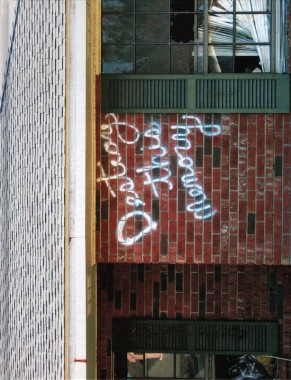
Richard Misrach, Destroy This Memory
Hardcover, 140 pp., offset 4/4, 11.75 x 15.25 inches
Edition of 2000
ISBN 978-15971116-3-8
Published by Aperture
$65.00 ·
Richard Misrach’s
Destroy This Memory is an affecting reminder of the physical and psychological impact of Hurricane Katrina. Rather than simply surveying the damage, Misrach — who has photographed the region regularly since the 1970s, most notably for his ongoing
Cancer Alley project — found himself drawn to the hurricane-inspired graffiti: messages scrawled in spray paint, crayons, chalk, or whatever materials happened to be on hand. At turns threatening, desperate, clinical, and even darkly humorous, the phrases he captured — the only text that appears in the book — offer unique and revealing human perspectives on the devastation and shock left in the wake of this disaster.
Destroy This Memory presents previously unpublished and starkly compelling material, all of which Misrach shot with his 4 MP pocket camera. Created between October and December 2005, this haunting series of images serves as a potent, unalloyed document of the raw experiences of those left to fend for themselves in the aftermath of Katrina.
Aperture, Art, Cancer Alley, Criticism, DAP, Katrina, New Orleans, Photography, Politics, Richard Misrach
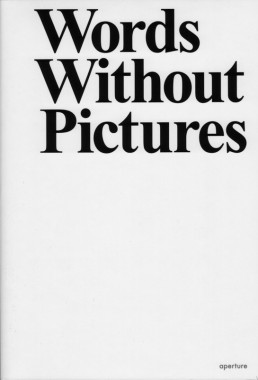
Alex Klein, Words Without Pictures
Softcover, 510 pp., offset 1/1, 5.75 x 8.25 inches
Edition of 2000
ISBN 978-1-5971114-2-3
Published by Aperture/LACMA
$25.00 ·
Words Without Pictures was originally conceived by curator Charlotte Cotton and artist Alex Klein as a means of creating spaces for discourse around current issues in photography. Every month for a year, beginning in November 2007, an artist, educator, critic or curator was invited to contribute a short unillustrated essay about an aspect of emerging photography. Each piece was available on the Words Without Pictures
website for one month and was accompanied by a discussion forum focused on its specific topic. Over the course of its month-long “life,” each essay received both invited and unsolicited responses from a wide range of interested parties. All of these essays, responses and other provocations are gathered together here. Previously issued as a print-on-demand title, we are pleased to present
Words Without Pictures to the trade for the first time as part of the
Aperture Ideas series.
A. L. Steiner, Alex Klein, Alex Slade, Allan McCollum, Allen Ruppersberg, Amir Zaki, Amy Adler, Anthony Pearson, Aperture, Art, Arthur Ou, Carter Mull, Charlie White, Charlotte Cotton, Christopher Bedford, Criticism, DAP, Darius Himes, David Reinfurt, Dexter Sinister, George Baker, Harrell Fletcher, James Welling, Jason Evans, John Divola, Kevin Moore, LACMA, Leslie Hewitt, Marisa Olson, Mark Wyse, Michael Queenland, Miranda Lichtenstein, Paul Graham, Penelope Umbrico, Photography, Sarah Charlesworth, Shannon Ebner, Sharon Lockhart, Soo Kim, Sze Tsung Leong, Theory, Walead Beshty, Wallis Annenberg Photography Department
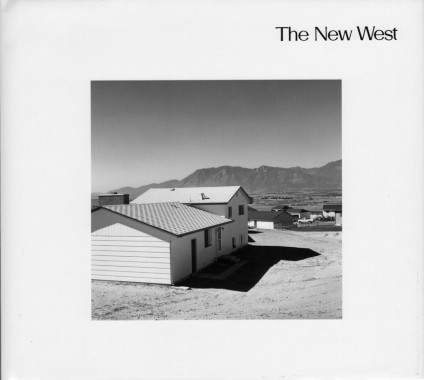
Robert Adams, The New West
Softcover, 136 pp., offset 1/duotone, 260 x 230 mm
Edition of 2000
ISBN 9781597110600
Published by Aperture
$45.00 ·
Originally published in 1974, Robert Adams’ The New West signaled a paradigm shift in the photographic representation of American landscapes. Foregoing photography’s traditional role of romanticizing the Western landscape, Adams focused instead on the construction of tract and mobile homes, subdivisions, shopping centers and urban sprawl in the suburbs of Colorado Springs and the Denver area. Adams transmuted these zones with his minimalist vision of their austerity; as he has noted, “no place is boring, if you’ve had a good night’s sleep and have a pocket full of unexposed film.” Objective and direct, Adams’ photographs, rendered in his signature middle-gray scale, unsentimentally depict a despoiled landscape washed in the intense Colorado sunlight. Today The New West stands alongside Walker Evans’ American Photographs, Robert Frank’s The Americans and Stephen Shore’s Uncommon Places in the pantheon of landmark projects on American culture and society. This second reissue of the classic publication has been recreated from Adams’ original prints.
Aperture, Art, DAP, John Szarkowski, Photography, Robert Adams, Robert Frank, Stephen Shore, Walker Evans
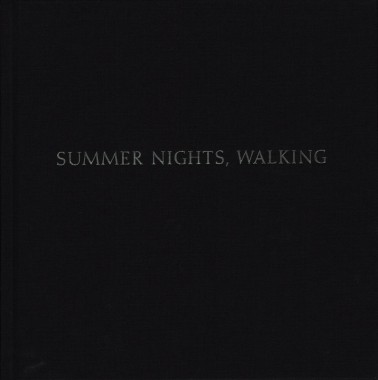
Robert Adams, Summer Nights, Walking
Softcover, 84 pp., offset 1/tritone, 8.75 x 9 inches
Edition of 2000
ISBN 9781597111171
Published by Aperture
out of stock
In this exquisitely produced book, the influential American photographer Robert Adams revisits the classic collection of nocturnal landscapes that he began making in the mid-1970s near his former home in Longmont, Colorado. Originally published by Aperture in 1985 as Summer Nights, this new edition has been carefully reedited and resequenced by the photographer, who has added 39 previously unpublished images. Illuminated by moonlight and streetlamp, the houses, roads, sidewalks and fields in Summer Nights, Walking retain the wonder and stillness of the original edition, while adopting the artist’s intention of a dreamy fluidity, befitting his nighttime perambulations. The extraordinary care taken with the new reproductions also registers Adams’ attention to the subtleties of the night, and conveys his appeal to look again at places we might have dismissed as uninteresting. Adams observes, “What attracted me to the subjects at a new hour was the discovery then of a neglected peace.”
Aperture, Art, Photography, Robert Adams, Yale University Art Gallery
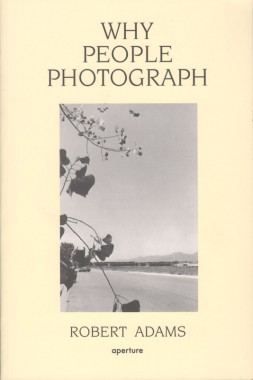
Robert Adams, Why People Photograph
Softcover, 189 pp., offset 1/1, 5.5 x 8.25 inches
Edition of 2000
ISBN 9780893816032
Published by Aperture
$15.00 ·
A now classic text on the art, Why People Photograph gathers a selection of essays by the great master photographer Robert Adams, tackling such diverse subjects as collectors, humor, teaching, money and dogs. Adams also writes brilliantly on Edward Weston, Paul Strand, Laura Gilpin, Judith Joy Ross, Susan Meiselas, Michael Schmidt, Ansel Adams, Dorothea Lange and Eugène Atget. The book closes with two essays on “working conditions” in the nineteenth- and twentieth-century American West, and the essay “Two Landscapes.” Adams writes: “At our best and most fortunate we make pictures because of what stands in front of the camera, to honor what is greater and more interesting than we are.”
Ansel Adams, Aperture, Criticism, DAP, Dorothea Lange, Edward Weston, Eugène Atget, Judith Joy Ross, Michael Schmidt, Paul Strand, Photography, Robert Adams, Susan Meiselas, Theory
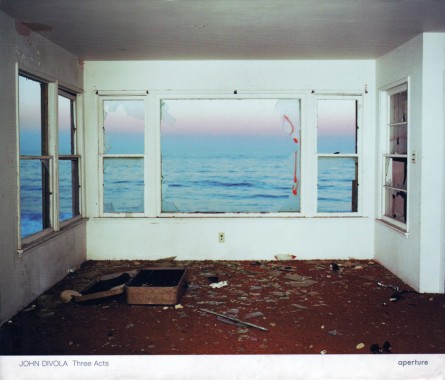
John Divola, Three Acts
Hardcover, 144 pp., offset 4/duotone, 11 x 9.25 inches
Edition of 2000
ISBN 9781931788953
Published by Aperture
$50.00 ·
In 1973, California artist John Divola began the first of three highly ambitious and original bodies of work that form Three Acts, the first book dedicated to them. His Vandalism series comprises black-and-white photographs of interiors of abandoned houses. Entering illegally, Divola spray-painted markings that referenced action painting as readily as the graffiti that was then becoming a cultural phenomenon. For the following year’s Los Angeles International Airport Noise Abatement series, he photographed a condemned neighborhood bought out to serve as a noise buffer for new runways, focusing on evidence of previous unsanctioned entries by other vandals. His final work, Zuma, documents the destruction of an abandoned beachfront property by the artist and others, as it deteriorates frame by frame and eventually burns. Divola has much in common with artists such as Bruce Nauman and Robert Smithson who have used photography to investigate other topics. He describes his innovative practice succinctly: “My acts, my painting, my photographing, my considering, are part of, not separate from, this process of evolution and change. My participation was not so much one of intellectual consideration as one of visceral involvement.”
Aperture, Art, DAP, David Campany, Francesca Richer, Jan Tumlir, John Divola, Michael Famighetti, Photography
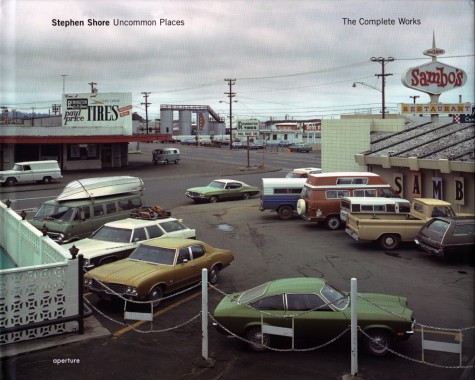
Stephen Shore, Uncommon Places
Hardcover, 188 pp., offset 4/4, 12.75 x 10.5 inches
Edition of 5000
ISBN 9781931788342
Published by Aperture
$55.00 ·
Published by Aperture in 1982 and long unavailable, Stephen Shore’s legendary Uncommon Places has influenced a generation of photographers. Among the first artists to take color beyond advertising and fashion photography, Shore’s large-format color work on the American vernacular landscape stands at the root of what has become a vital photographic tradition. Uncommon Places: The Complete Works presents a definitive collection of the original series, much of it never before published or exhibited. Like Robert Frank and Walker Evans before him, Shore discovered a hitherto unarticulated version of America via highway and camera. Approaching his subjects with cool objectivity, Shore’s images retain precise internal systems of gestures in composition and light through which the objects before his lens assume both an archetypal aura and an ambiguously personal importance. In contrast to Shore’s signature landscapes with which Uncommon Places is often associated, this expanded survey reveals equally remarkable collections of interiors and portraits. As a new generation of artists expands on the projects of the New Topographic and New Color photographers of the seventies — Thomas Struth (whose first book was titled Unconscious Places), Andreas Gursky and Catherine Opie among them — Uncommon Places: The Complete Works provides a timely opportunity to reexamine the diverse implications of Shore’s project and offers a fundamental primer for the last 30 years of large-format color photography.
Andreas Gursky, Aperture, Art, Catherine Opie, DAP, Lynne Tillman, Photography, Robert Frank, Stephan Schmidt-Wulffen, Stephen Shore, Thomas Struth, Walker Evans






